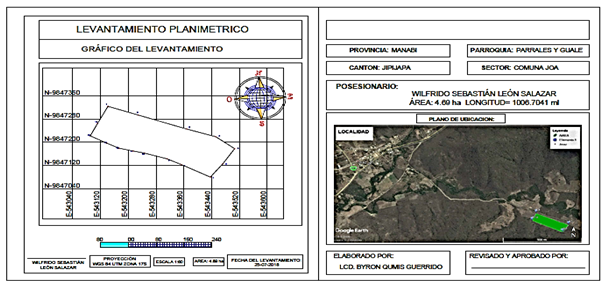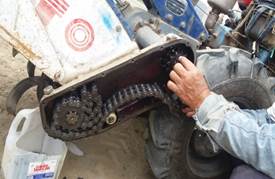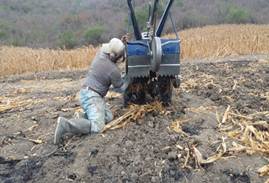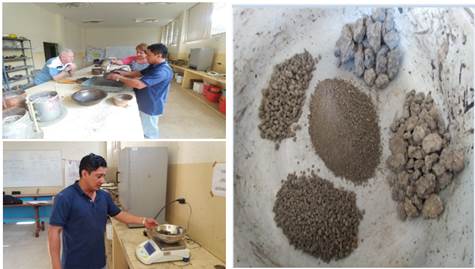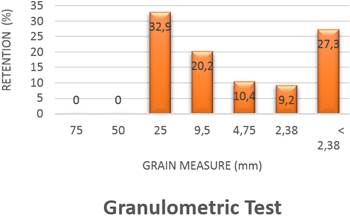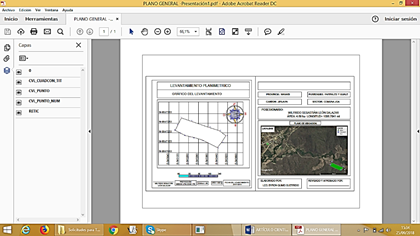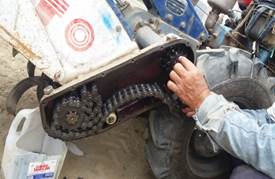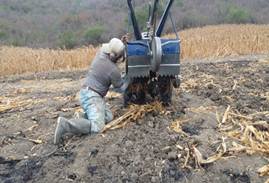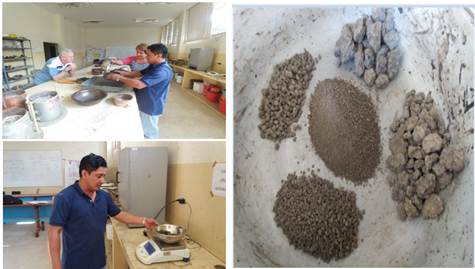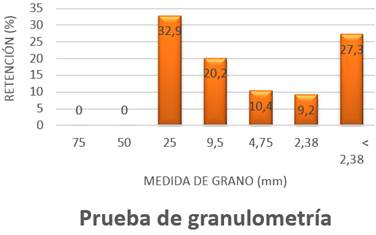ORIGINAL ARTICLE

http://opn.to/a/fMPLL
Technological and Operation Evaluation of the YTO DF-15L Rototiller in Soil Preparation for Watermelon
Lic. Byron Leonardo Quimis-Guerrido [I] [*]
Dr.C. Liudmyla Shkiliova [I]
[*] Author for correspondence: Byron Leonardo Quimis-Guerrido, e-mail: byronleonardoqg@hotmail.com
ABSTRACT
The
present research was carried out in Joa Commune of Jipijapa Canton,
Manabí Province, Ecuador. The objective of the work was to determine
technological and operation indexes of the YTO DF-15L rototiller with
rotary plow in the preparation of soil for the cultivation of
watermelon. The methodology to determine the technological and operation
indexes was based on the chronometric observation, with the use of the
Cuban standard 34-37: 2003. To determine the physic-mechanical
properties of the soil the AASHTO standard T-88 was used. The main
results showed that the appropriate type of soil for watermelon sowing
is with a sandy loam texture, of flat relief and with gravimetric
humidity of 18.52%. In addition, it should have a resistance to
penetration of 1,0 MPa as average, which allows affirming that the soil
is in conditions of good growth for the plant. The obstruction in the
field due to harvest remains was 1200 kg / ha. The productivity per hour
of operation time was 0.05 ha / h and the coefficient of use of
productive time was 0.96. During the observation period, only one break
in the rotary plow propellant chain was recorded, the technical safety
coefficient was 0.97, the depth of soil preparation reached 15,9 cm and
the quality of fluffy soil was satisfactory. It was concluded that the
technological and operation indexes of the YTO DF-15L rotary tiller in
the preparation of soil were satisfactory, being recommended to the
producers to sow watermelon seeds, not on flat terrain, but on ridges
with a height of 10 to 20 cm, which can be made with manual tools.
Keywords:
indexes; chronometric observation; rotary tiller; productivity.
The
agricultural sector of Ecuador is distinguished by the duplicity
productive, on one side the production units of more than 100 ha, with
technical, technological and economic sufficiency, oriented to supply
external markets and by the other side the UPA (Agricultural Productive
Units), small extensions between one and five hectares, limited in
technology, productivity and even credit lines. To respond to the
demands of small farmers and contribute to the process of modernization
of the rural sector, since 2014 in the province of Manabi, the program
"Community Agricultural Mechanization" is being developed. The first
stage of the program consisted of the delivery to the agricultural
associations of 1 942 power tractors and 94 agricultural tractors,
YTO-704, with the main implements, acquired in 2009 by the National
Development Bank (BNF), currently Ban Ecuador. It was done to technify
the work on the land, reduce labor costs and increase the production of
small and medium producers in the province (Cevallos & Shkiliova, 2016).
The mechanization of small plots is not very profitable and it is very
difficult with the use of tractors or practically impossible, if there
are other factors, such as abrupt slopes, stoniness or the low bearing
capacity of soils due to their high water content (flood), or requires
the use of highly specialized machinery. In these situations the motor
cultivators are the only motorized equipment that can act (Márquez, 2010).
The
tiller (also known as a two-wheel tractor, single-axle tractor, walking
tractor) with different implements can do many types of agricultural
work, such as tillage, harvest, planting and transportation. At present,
there is a large number of designs of power tillers around the world,
to serve the different markets. Among them, the Chinese machinery is of
relatively low cost, which is widely used not only in China, but also by
small African farmers and Latin Americans (Chew et al., 2013).
In Ecuador, the Chinese YTO DF-15L traction machines provided by the
MAGAP prevail. The distribution was made throughout the country, in
different provinces, to organizations and associations previously
qualified by the MAGAP, even theoretical and practical training was
given to the beneficiaries on the proper use of the machinery. In Costa
region, 777 motor cultivators were handed over, representing 40% of the
total, 140 of them were delivered in Manabí Province (MAGAP, 2014). According to INEC (2000),
the province of Manabí, at the beginning of the 20th century had 74 676
UPA, which used 1 583 661 ha to produce. Specifically for the transient
crop of watermelon, 733 UPA occupied 969 ha for planting. Jipijapa
County had 8.491 UPA, with availability of 90 129 ha for production, 60
of them dedicated to the cultivation of watermelon in 63 ha. Watermelon (Citrullus lanatus),
native to African countries, is one of the most widespread fruits in
the world today. The Ecuadorian production of watermelon dates
approximately from years 70, being Manabí and Los Ríos the main
provinces that cultivate this fruit, for their appropriate climate for
the production process required. The best temperature range average for
the production of watermelon during the growing season is between 18 °C
and 35 °C. The optimum climate is warm-dry with annual temperature
between 23 °C and 28 °C (InfoAgro, 2000)
and average annual temperature of Manabí is 24 °C. Soil preparation to
sow watermelon should be done 30 days before planting, usually this work
is done in a mechanized or manual way. To achieve a good harvest of
watermelon it is important to know the type of soil in which it is going
to be planted and for that it is necessary to carry out a soil sampling
to determine if it is suitable for this crop or not. According to data
from ESPAC (2017), 89.43% of producers in
Ecuador have never performed a soil analysis and only 5.07% did so less
than one year. The watermelon crop has a root system classified as deep,
it can penetrate more than one meter into the soil. For this reason,
the type of soil where the sowing is established and the adequate
preparation of the land represent very important aspects in the growth
of the plant. The ideal soil for sowing watermelon is deep, loose and
well drained (Martínez, 2015). The selected
soil must be flat, preferably loamy-clay or loamy-sandy soil, of a good
physical structure not compacted, free of perennial weeds and residues
of previous crops.
Watermelon
cultivation is established in very variable soils, from clay loams to
sand and sandy loams, so the soil preparation can change (INIFAP, 2000). Soil preparation tasks should be done according to the degree of moisture contained in it, not too wet or too dry (Casaca, 2005). In Jipijapa Canton, according to Garcés (2018),
a decreasing of watermelon producers is observed in recent years. If in
2015, there were about 45 producers, in 2017 there were only 30,
highlighting that there are producers who do not have the necessary
training to be able to produce watermelon properly. Joa Commune,
belonging to Jipijapa Canton, in 2018, opted to diversify the crops and
plant the hybrid seed watermelon Glory Jumbo (Charleston Gray) on the
land previously occupied by corn, which had never been plowed. To
prepare the soil, due to the lack of tractors, agricultural producers
decided to use only the YTO DF - 15L rotary tiller with rotary plow,
which was delivered to the commune in 2014. They considered it was used
in the same work in lands near the river and a good harvest of
watermelon was achieved. The objective of this paper is to present the
results of determining the technological-operational indices and the
evaluation of the working quality of the YTO DF-15L rototiller with the
rotary plow in soil preparation for watermelon cultivation in Joa
Municipality. Jipijapa Canton, Manabí Province, Ecuador.
The
present research was carried out in August 2018, in Joa Municipality,
located 6 km west of Jipijapa City, Manabí Province, which has an
equatorial dry forest climate with an average temperature of 24 oC.
Joa Commune has approximately 350 inhabitants, dedicated to short-cycle
agriculture: corn, peanuts, vegetables and cucurbits (Gad, 2015). The area selected by the producers for watermelon sowing, according to the geo-referencing made with a GPS GARMIN 64 (Figure 1)
was 4,69 ha. Before soil preparation, farmers cut dry pancas from the
previous crop (corn) with a scythe and burned the wastes as usual
practice.
FIGURE 1.
Location of the selected area for sowing watermelon in Joa Municipality.
To determine the type and
characteristics of soil in the observation area, three zigzag soil
samples were taken, each composed of 20 sub-samples, at 20 cm, 25 cm and
30 cm depth (Sosa , 2012 and Lizcano , 2017)
to determine hydrophysical and mechanical parameters, bulk density,
field capacity, gravimetric humidity, porosity and textural class. Soil
compaction was determined with an AGRATRONIX cone-type analog
penetrometer, 08180 with a precision of 2 kgf and a penetration depth of
up to 60 cm in increments of 7.62 cm (AgraTronix, 2004). Obstructions in the plot due to crop residues were verified by mass weight in an area of 1 m2 (NC 34-37: 03, 2003; de las Cuevas et al., 2015).
In the laboratory conditions, by means of the Bouyoucos Method and textural triangle according to USDA classification SSDS (1993), the texture of the soil was established; and through the AASHTO T 88 (2004)
standard, the granulometric analysis of soil by sieving was carried out
to evaluate the quality of soil softening with a rotary plow (Iglesias, 2002).
The main devices used in the laboratory were a digital balance (ADAM)
with sensitivity of 0,01 g to weigh material, a series of SOILTEST
sieves composed of 75mm, 50mm, 25mm 9.5mm 4.75mm and 2.38mm sieves.
Other devices used were a stove (QL Model 40 GC Lab Oven) capable of
maintaining uniform and constant temperatures up to 110 °C ± 5 °C (230
°F ± 9 °F) and a soil hydrometer (Gilson ASTM 152 H) with sensitivity of
1 g/L. For the evaluation of the technological and operation indexes of
the YTO DF-15L rototiller (Table 1) in the soil preparation work, preceding watermelon sowing, the methodology based on the Cuban standard NC 34-37: 03 (2003)
was used. The operating and inactivity times were measured during work
shifts using a digital chronometer (CASIO) with precision of 1 s,
annotated and classified as they are described in Table 3.
Subsequently, these times were used to calculate productivities per
hour of different time categories and operating coefficients.
The
fuel consumed by the YTO DF-15L rototiller during the work shift was
obtained through the measurement at the start and end of each day,
completing the fuel tank of 16 L at the end of the period. In the
morning, at the beginning of the new workday, for the transfer from the
field to the communal house and vice versa. To determine the depth of
tillage after passing the tiller with rotary plow, the depth reached was
measured, taking 30 data from the surface to the untreated area of the
soil and using a 5 m flexometer with a precision of 1 mm. The working
speed was calculated on the basis of measurements of the time the rotary
tiller lasted in covering 50 m of distance, with three repetitions (Iglesias, 2002)
and using a digital chronometer with an appreciation of 1 s. The
processing of collected data was done through EXCEL spreadsheets and the
AutoCAD 2014 / CivilCAD 2014 program.
TABLE 1.
Technical characteristics of the YTO DF-15FL rototiller
| Model | DF-15L |
|---|
| Tipe | Single purpose dual axis for traction and transmission. |
| Overall dimensions, (L x W x H mm) | 2680 x 960 x 1250 |
| Gauge width, mm | Fit among 800, 740, 640 and 580 |
| Minimum clearance, mm | 182 from the floor to the bottom of the final transmission. |
| Routing width, mm | 600 |
| Minimum turning radius, m | 0.9 without rototiller |
| Weight, kg | 509/499 |
| Transmission system: |
| a. Bands from engine to clutch | Bands type "V" |
| b. Clutch type | Double friction disc and constant contact. |
| c. Rototiller | Assembly with pressure roller chain, short format 12A-2 x 50 |
| Tractive force. | 221 kg-f |
| Rototiller speed, min-1 | 211/345 low / high |
| Diesel engine |
| a. Model | S1100A2N |
| b. Output power, kW/hp | 12/16 |
| c. Maximum torque, N.m | 257 |
Characterization of the Observation Area
The
condition of the soil in the observation area where the work of the YTO
DF-15L rototiller with the rotary plow was evaluated is shown in Table 2.
TABLE 2.
Characteristics of the experimental area, Joa Commune
| Denomination U/M Values obtained |
|---|
| Type of soil - Loamy Sandy Franco |
| Relief - Plain |
| Previous cultivation - Corn |
| Cultivation to be sown Watermelon |
| Gravimetric humidity % 18.52 |
| Resistance of the soil, before labor in the:
Depth 7.62 cm MPa 0.8 Depth 15.24 cm MPa 0.9 Depth 22,86 cm MPa 1,0 Depth 30.48 cm MPa 1.1 Depth 38.10 cm MPa 1.1 Depth 45,72 cm MPa 1.0
|
| Field capacity % 30.33 |
| Porosity % 47.73 |
| Apparent density g/cc 1.31 |
| Obstruction due to harvest kg/ha 1,200 |
The results show that the soil is
suitable for the cultivation of watermelon. It is of fine texture,
Franco Sandy Argillaceous, coinciding that in Jipijapa Canton soils of
fine texture predominate, being 72% of the total territory clay soils
and called strong or heavy soils (Gad, 2015). According to Casaca (2005),
the sandy loam to franc soils are the best for the development of the
plants, however, franc clayey to clayey soils can be used, the latter
with amendments (aggregation of organic matter). In addition, the fine
textures soils present greater possibilities of contact with the
absorbent radical hairs (Humphrey, 2017).
The
flat relief with a slope of less than 2%, almost no stony, good
drainage and gravimetric moisture of 18.52% of the soil, allow the work
of the plow tiller rotary. The field capacity 30,33%, the porosity of
47.73% classified as average and the apparent density 1.31 g/cm3, is considered high in fine textured soils (Delgadillo and Alcalá, 2010).
From the measurement of the resistance of the soil to the penetration
in depths from 7.62 cm to 45.72 cm, values from 0.8 MPa to 1.1 MPa were
obtained, for an average of 1.0 MPa, which allows affirming that the
soil was in conditions of good growing for the plant (http://equipamientocientifico.com).
It was classified as in intermediate low (0.1 MPa to < 1 MPa) and
moderate intermediate levels (1 MPa to < 2 MPa) according to SSDS
classification (1993) and Safar et al. (2011).
Time recordings by the timing technique of the YTO DF-15L rototiller on three working days showed in Table 3
that the general observation time was 18.92 h, of these 15.2 h
correspond to clean time of work. During the observation period on the
first day, there was a break in the chain that propels the rotary plow (Figure 1)
at 3.43 h after the start of the work and for the elimination of this
fault, 0.53 h (T42) were necessary. A technological failure was also
recorded (Figure 2) due to soil obstacles,
which was solved in 0.13 h. The time of transfer to the field and vice
versa was 2.38 h, which is related to the distance of the field from the
parking place.
TABLE 3.
Results of measuring working time of the YTO DF-15L
| SYMBOL | DENOMINATION | h |
|---|
| T1 | Clean work time | 15,2 |
| T31 | Time for the execution of the daily technical maintenance | 0,48 |
| T42 | Time to eliminate technical failures | 0,53 |
| T5 | Rest time of service personnel of the testing machine | 0,2 |
| T61 | Transfer time to the field or vice versa | 2,38 |
| | Total observation time | 18,92 |
FIGURE 1.
Break of propulsive chain.
FIGURE 2.
Technological failure.
According to the classification of the types and forms of movements of the sets, the operator used the rolling movement (Figure 3), whose characteristic is that the work pass is made along and across the field, avoiding any time losses in turning.
FIGURE 3.
For the organization of the territory, rolling movement.
Table 4 shows the results of calculating productivity indices of the YTO DF-15L rototiller during the observation period.
TABLE 4.
Productivity indices of the YTO DF-15L
| Name of the indices | Value | U/M |
|---|
| Volume of work done | 0,92 | ha |
| Productivity per hour of clean time (W01) | 0,06 | ha/h |
| Productivity per hour of operating time (W02) | 0,06 | ha/h |
| Productivity per hour of productive time (W04) | 0,06 | ha/h |
| Productivity per hour of shift time without failure (Wt) | 0,05 | ha/h |
| Productivity per hour of exploitation time (W07) | 0,05 | ha/h |
The working productivity of a
rototiller is a function of the width, speed and efficiency of the work.
The productivity per hour of clean time (W01), operating time (W02) and productive time (W04)
was approximately 0.06 ha/h, considering that there were no expenses of
auxiliary time and expenses of time for the maintenance and the
elimination of failures were minimal. Productivities by other time
categories reached the approximate value of 0.05 ha/h. These results are
similar to the productivity of 0,05 ha/h obtained during the plowing
tests of the DF-15L and DF-12 tractors Kebede & Getnet (2016).
Nevertheless, they were lower than those achieved by the KUBOTA
rototiller in strawberry set, which was 0.09 ha/h and 0.07 ha/h of clean
and productive time respectively in soil preparation for rice (Chedré et al., 2005).
The values of the operating coefficients, calculated based on primary timing data, are shown in Table 5.
TABLE 5.
Operation coefficients of the YTO DF-15L
| Denomination of the coefficients | Value |
|---|
| Coefficient of work passes (K 21) | 1,00 |
| Technological service coefficient (K 23) | 1,00 |
| Technical maintenance coefficient (K 3) | 0,97 |
| Technological safety coefficient (K 41) | 0,99 |
| Technical safety coefficient (K 42) | 0,97 |
| Coefficient of use of productive time (K 04) | 0,96 |
| Coefficient of utilization of exploitative time (K 07) | 0,96 |
As it can be seen, practically all
operating coefficients reached values equal to or close to 1.0 during
the observation period, due to the speed with which they eliminated the
chain failure and technological failure. These results are largely due
to the experience of the operator of the rototiller and his constant
dedication to work.
The
fuel consumption of the YTO DF-15 L rototiller in the preparation of
0.92 ha of soil was 15.2 L. The specific cost per unit of work performed
of 16.52 L/ha, which is less than 18.42 L/ha of the DF-15L Kebede & Getnet (2016), but superior to the consumption of the KUBOTA rototiller that reached values between 13-15 L/ha (Chedré et al., 2005).
The fuel expense per hour of exploitation time was 0.91 L/h, which is
approximately the reported of 1.00 L/h by the DF-15L walking tractor (Kebede & Getnet, 2016).
The
soil preparation for watermelon sowing was carried out in two rotary
plow tiller passes. In the first working pass of the rototiller at an
average speed of 1.7 km/h, an average depth of 8.9 cm ± 1.3 cm was
recorded. In the second pass, an average depth of 15.9 cm ± 1.2 cm was
reached at a working speed of 1.84 km / h. The working width of the
rotary plow was on average 68 cm. The working speed of the tiller was
between the first and second theoretical speeds (1.4 km/h and 2.5 km/h),
depending on the manufacturer (Manual YTO). The depth of work achieved
in two passes is similar to that reported (15.23cm ± 1.23 cm) in the
DF-15L rototiller test in plowing (Kebede & Getnet, 2016).
By
preparing the soil, conditions are created to facilitate the
germination of the seed or the establishment of the transplant and
subsequent development of the plant. Each climate-soil-cultivation
system presents specific problems that will require different tasks. In
the case of watermelon, it must be taken into account that its root
system is of deep type and any obstacle present for the development of
it, will affect the crop (Martínez, 2015).
The traditional or conventional system of soil preparation is the use of
plow, harrow and rake, with the plowing to the depth of up to 20 cm ...
30 cm (Casaca, 2005 and Masabni and Lillard, 2013).
Other authors do not specify the depth of soil preparation, referring
that for the planting of watermelon in the open air, harrow or plow
works are necessary to loosen the soil. There are experiences of soil
preparation to sow watermelon only with hand tools. The project
developed in Ecuador "Ecological production and marketing of watermelon
and onion in “Canta Gallo Jipijapa Canton" is one of them. In that
project, it was decided not to perform any type of mechanized tillage,
so furrows were made manually, spaced at 50 cm, in parallel lines (Quimís, 2007).
In Joa Commune, they have the experience of soil preparation with two
passes of YTO DF-15L Rototiller, in Loamy Sandy Franco soils near the
river and obtaining good harvest of watermelon.
Based
on the above and taking into account that the soil in the observation
area has good conditions for watermelon growth (not compacted), the soil
preparation depth reached by the YTO-DF-15L rototiller can be
considered acceptable. It is recommended to the producers that, before
planting watermelon, form ridges of height of 10 cm to 20 cm with a hand
tool, to facilitate the development of roots, improve aeration, and
manage water and fertilizers (Martínez, 2015).
The quality of soil loosening was determined by the ratio of the mass
of lump fractions smaller than 50 mm to the total mass of the soil
sample, expressed in hundreds. Approximately 80% of lumps of 1 mm to 50
mm in size should be granted at the upper level and the formation of
fractions of more than 75 mm is not allowed (Iglesias, 2002; Yarullin, 2015). The size of clods after the rotary plowing step was determined by granulometric soil analysis by sieving (Figure 4).
FIGURE 4.
Granulometric analysis of soil by sizing.
As it can be seen in Figure 5,
there was no lump retention in the 75 mm and 50 mm sieves. The highest
clod retention (492.79 g) corresponded to the 25 mm sieve representing
32.9% of the total mass; of the grains smaller than 2.38 mm, a mass of
409.9 g (27.3%) was obtained. The results show that the quality of
loosening was satisfactory.
FIGURE 5.
Graphic representation of granulometric test.
The
technological and exploitation evaluation of the YTO DF-15L rototiller
in the preparation of Franco Sandy Argillaceous soil, which meets the
requirements for the sowing of watermelon, showed satisfactory results
in the use of clean working time, which was equal to 15.2 h out of a
total of 18.72 h of observation.
The
productivity per hour of operation time was 0.05 ha/h, the coefficient
of use of productive time was 0.96. During the observation period, only
one break in the rotary plow propellant chain was recorded.
All
the operating coefficients reached values equal to or close to 1.00
during the observation period, obtaining the coefficient of technical
security the value of 0.97.
The quality
of the work done by the rotary plow is considered satisfactory,
fulfilling the agrotechnical requirements for the softness of the
superficial layer of soil. The depth of soil preparation reached of 15.9
cm ± 1.2 cm at a working speed of 1,84 km / h, is acceptable. It is
recommended, before sowing watermelon, to form ridges from 10 cm to 20
cm height with manual tool, to facilitate the development of roots of
the plant, improve aeration, and for the management of water and
fertilizers.
ARTÍCULO ORIGINAL
Evaluación tecnológica y explotación del motocultor YTO DF-15L en la preparación de suelo para sandía
Lic. Byron Leonardo Quimis-Guerrido [I] [*]
Dr.C. Liudmyla Shkiliova [I]
[I] Instituto de Postgrado, Universidad Técnica de Manabí, Portoviejo, Manabí, Ecuador.
[*] Autor para correspondencia: Byron Leonardo Quimis-Guerrido, e-mail: byronleonardoqg@hotmail.com
RESUMEN
La
presente investigación se realizó en la comuna Joá del cantón Jipijapa,
provincia de Manabí, Ecuador. El objetivo del trabajo es determinar los
índices tecnológicos y explotación del motocultor YTO DF-15L con arado
rotativo en la preparación de suelo para el cultivo de sandía. La
metodología para determinar los índices tecnológicos y explotación se
basó en la observación cronométrica, con la utilización de la norma
cubana 34-37:2003, para determinar las propiedades físico-mecánicas del
suelo se utilizó la norma AASHTO T-88. Los principales resultados
evidencian que el tipo de suelo para la siembra de sandía es apropiado,
de textura franco arenoso arcilloso, de relieve llano, con humedad
gravimétrica de 18,52%, la resistencia a la penetración alcanza un
promedio de 1,0 MPa, lo que permite afirmar que el suelo se encuentra en
condiciones de para buen crecimiento para la planta; la obstrucción en
el campo por restos de cosecha es de 1 200 kg/ha. La productividad por
hora de tiempo de explotación fue de 0,05 ha/h; el coeficiente de
utilización del tiempo productivo es igual a 0,96; durante el período de
observación se registró solo una rotura en la cadena propulsora del
arado rotativo, obteniendo el coeficiente de seguridad técnica el valor
de 0,97; la profundidad de preparación de suelo alcanzó 15,9 cm, la
calidad de mullido del suelo es satisfactoria. Se concluye que los
índices tecnológicos y de explotación del motocultor YTO DF-15L con
arado rotativo en la preparación de suelo fueron satisfactorios, siendo
recomendado a los productores realizar la siembra de semillas de sandía
no en terreno plano, sino en camellones con altura de 10…20 cm, los
cuales se puede conformar con herramientas manuales.
Palabras clave:
índices; observación cronométrica; arado rotativo; productividad.
El
sector agropecuario del Ecuador se distingue por la duplicidad
productiva, por un lado las unidades productoras de más de 100 ha, con
suficiencia técnica, tecnológica y económica, orientadas a abastecer
mercados externos y por otro lado las UPA (Unidades Productivas
Agropecuarias), pequeñas extensiones entre una y cinco hectáreas,
limitadas en tecnificación, productividad e incluso líneas crediticias.
Para
dar respuesta a las demandas de los agricultores pequeños y contribuir
con el proceso de modernización del sector rural, a partir del año 2014
en la provincia de Manabí se desarrolla el programa “Mecanización
Agrícola Comunitaria”. ´La primera etapa del programa consistió en la
entrega a las asociaciones agropecuarias de 1 942 motocultores y 94
tractores agrícolas marca YTO-704, con los principales implementos,
adquiridos en 2009 por el Banco Nacional de Fomento (BNF), actualmente
Ban Ecuador, con el fin de tecnificar la labor en la tierra, disminuir
costos de mano de obra e incrementar la producción de pequeños y
medianos productores de la provincia (Cevallos y Shkiliova, 2016).
La
mecanización de las pequeñas parcelas resulta poco rentable y muy
difícil con el uso de los tractores o prácticamente imposible, si
también existen otros factores, tales como fuertes pendientes, la
pedregosidad o la baja capacidad portante de los suelos por su elevado
contenido de agua (inundación), o requiere la utilización de maquinaria
altamente especializada. En estas situaciones son los motocultores los
únicos equipos motorizados que pueden actuar (Márquez, 2010).
El
motocultor (también conocido como tractor de dos ruedas, tractor de un
eje, tractor de caminar) con diferentes implementos puede realizar
muchos tipos de trabajos agrícolas, tales como labranza, cosecha,
plantación y transporte. En la actualidad se tiene un gran número de
diseños de motocultores en todo el mundo, para atender los distintos
mercados. Entre ellos, se destaca la maquinaría china, de costo
relativamente bajo, que se utiliza ampliamente no sólo en China, sino
por los pequeños agricultores africanos y latinoamericanos (Chew et al., 2013).
En
el Ecuador prevalecen los motocultores chinos de la marca YTO DF-15L
proporcionados por el MAGAP. La distribución se realizó por todo el
país, en diferentes provincias a organizaciones y asociaciones
previamente calificadas por el MAGAP, incluso se brindó capacitación
teórico - práctica a los beneficiarios sobre el uso adecuado de la
maquinaria. En la región Costa se entregó 777 motocultores que
representan el 40% del total, de éstos en la provincia de Manabí 140 (MAGAP, 2014).
Según INEC (2000),
la provincia de Manabí, al principio del siglo XX tenía 74 676 UPA,
quienes utilizaban para producir 1 583 661 ha, específicamente para el
cultivo transitorio de sandía existían 733 UPA que ocupaban 969 ha para
su siembra; el cantón Jipijapa tenía 8 491 UPA, con disponibilidad de 90
129 ha para la producción, de éstas dedicadas al cultivo de sandía
había 60 UPA ocupando 63 ha para su siembra.
La sandía (
Citrullus lanatus)
, originaria de países de África y una de las frutas más extendidas
actualmente por el mundo. La producción ecuatoriana de sandía data
aproximadamente desde los años 70, siendo Manabí y Los Ríos las
principales provincias que cultivan esta fruta, por su clima apropiado
para el proceso de producción requerido. El mejor rango de temperatura
promedio para la producción de sandía durante la temporada de
crecimiento es entre 18°C y 35°C, siendo el óptimo un clima cálido-seco
con temperatura anual entre de 23°C y 28°C InfoAgro (2000), destacando que la temperatura promedio anual de Manabí es de 24°C.
La
preparación de suelo para la siembra de sandía se debe realizar con 30
días de antelación a la siembra, generalmente esta labor se realiza en
forma mecanizada o manual. Para lograr una buena cosecha de sandía es
importante conocer el tipo de suelo en el cual se va a sembrar, para
esto es necesario realizar un muestreo de suelo para determinar si el
mismo es adecuado o no para dicho cultivo. Según datos del ESPAC (2017),
el 89,43% de personas productoras en el Ecuador nunca han realizado un
análisis de suelo y sólo 5,07% lo hizo menos de un año.
El
cultivo de sandía posee un sistema de raíces clasificado como profundo,
el mismo puede penetrar más de un metro en el suelo. Por tal razón, el
tipo de suelo donde se establezca la siembra y la preparación adecuada
del terreno representan aspectos muy importantes en el crecimiento de la
planta. El suelo ideal para la siembra de sandía es profundo, suelto y
de buen drenaje (Martínez, 2015). El
terreno seleccionado debe ser de un suelo plano, preferiblemente
franco-arcilloso o franco-arenoso, de una buena estructura física no
compactado, libre de malezas perennes y de residuos de cultivos
anteriores.
El cultivo de sandía se
establece en suelos muy variables, desde migajones arcillosos hasta
francos arenosos y arenosos, por lo cual puede variar la preparación del
suelo (INIFAP, 2000). Las labores de
preparación del suelo deberán hacerse de acuerdo al grado de humedad que
contenga éste, no muy húmedo ni excesivamente seco (Casaca, 2005).
En el cantón Jipijapa, según el estudio de Garcés (2018),
en los últimos años se observa la disminución de productores de sandía,
si en el 2015 existía alrededor de 45 productores, en el 2017 sólo se
contaba con 30, destacándose que existen productores que no tienen la
capacitación necesaria para poder realizar la producción de sandía en
forma adecuada.
La comuna Joá,
perteneciente al cantón Jipijapa, en el año 2018 optó diversificar los
cultivos y sembrar la sandía de semilla híbrida Glory Jumbo (Charleston
Gray) en el terreno ocupado con anterioridad por maíz, que nunca fue
arado. Para la preparación de suelo, por no disponer de tractores, se
decide por parte de productores agrícolas utilizar sólo el motocultor
YTO DF - 15L con arado rotativo, que fue entregado a la comuna en el año
2014, teniendo en cuenta que éste se utilizó en la misma labor en
terrenos cercanos al río y se logró una buena cosecha de sandía.
El
objetivo de este trabajo es exponer los resultados de la determinación
de los índices tecnológico-explotativos y de evaluación de la calidad de
trabajo del motocultor YTO DF - 15L con el arado rotativo en la
preparación de suelo para cultivo de sandía en la comuna Joá del cantón
Jipijapa, provincia de Manabí, Ecuador.
La
presente investigación se realizó en el mes de agosto del año 2018, en
la comuna Joá, ubicada a 6 km al Oeste de la ciudad de Jipijapa de la
provincia de Manabí, la cual posee un clima de bosque seco ecuatorial
con una temperatura media de 24oC. La comuna Joá tiene
aproximadamente 350 habitantes, dedicados a la agricultura de ciclo
corto: maíz, maní, hortalizas y cucurbitáceas (Gad, 2015).
El área seleccionada por los productores para la siembre de sandía, según la georeferenciación realizada con un GPS GARMIN 64 (Figura 1)
fue igual a 4,69 ha, donde antes de la labor de preparación de suelo
con una guadaña se cortó las pancas secas del cultivo anterior (maíz) y
se quemaron los residuos como tradicionalmente lo hacen los agricultores
de la zona
FIGURA 1.
Ubicación del área seleccionada para la siembra de sandía en la comuna Joá.
Para determinar el tipo y
características de suelo en el área de observación se tomaron tres
muestras de suelo en zigzag, cada una compuesta por 20 sub muestras, a
20 cm; 25 cm y 30 cm de profundidad según Sosa (2012) y Lizcano (2017),
para determinar parámetros hidrofísicos y mecánicos, densidad aparente;
capacidad de campo; humedad gravimétrica; la porosidad; y clase
textural. La compactación de suelo fue determinada con un penetrómetro
análogo de cono de marca AGRATRONIX, 08180 con precisión de 2 kgf, con
la profundidad de penetración de hasta 60 cm en incrementos de 7,62 cm (AgraTronix, 2004). Las obstrucciones en la parcela por residuos de cosecha se comprobaron mediante el peso de masas en un área de 1 m2 (NC 34-37: 03, 2003; de las Cuevas et al., 2015).
En
las condiciones de laboratorio mediante el método de Bouyoucos y
triángulo textural según clasificación USDA SSDS (1993) se estableció la
textura del suelo; y mediante la norma AASHTO T 88 (2004),
se realizó el análisis granulométrico de suelo por tamizado para
evaluar la calidad de mullición del suelo con arado rotativo (Iglesias, 2002).
Los principales aparatos utilizados en el laboratorio fueron los
siguientes: una balanza digital (ADAM) con sensibilidad de 0,01 g para
pesar material; una serie de tamices SOILTEST integrada por los
siguientes:75mm; 50mm; 25mm; 9,5mm; 4,75mm y 2,38mm; estufa (QL Model 40
GC Lab Oven), capaz de mantener temperaturas uniformes y constantes
hasta de 110°C ± 5 °C (230°F ± 9 °F), un hidrómetro de suelos Gilson ASTM (2007) con sensibilidad de 1 g/L.
Para la evaluación de los índices tecnológicos y explotación del motocultor YTO DF-15L (Tabla 1) en la labor de preparación de suelo, previa a la siembra de sandía, se utilizó la metodología basada en la norma cubana NC 34-37: 03 (2003).
Los tiempos operativos y de inactividad se midieron durante turnos de
trabajo utilizando un cronómetro digital (CASIO) con precisión de 1 s,
anotados y clasificados como están descritos en la Tabla 3.
Posteriormente estos tiempos se utilizaron para el cálculo de
productividades por hora de diferentes categorías de tiempo y de
coeficientes de explotación.
El
combustible consumido por el motocultor YTO DF-15L durante el turno de
trabajo, se obtuvo a través de la medición al inicio y final de cada
jornada, completando el tanque de combustible de 16 L al final del turno
y en mañana al iniciar la nueva jornada de trabajo, por el traslado del
campo a la casa comunal y viceversa.
Para
determinar la profundidad de labranza después del pase del motocultor
con arado rotativo se midió la profundidad alcanzada, tomando 30 datos
desde la superficie hasta la zona no labrada del suelo, utilizando un
flexómetro de 5 m con precisión de 1 mm.
La
velocidad de trabajo se calculó en base de mediciones en una distancia
de 50 m del tiempo en que el motocultor con arado rotativo tarda en
recorrerla, con tres repeticiones según Iglesias (2002), se utilizó un cronómetro digital con apreciación de 1 s.
El
procesamiento de datos recolectados se realizó a través de hojas de
cálculo de EXCEL y el programa AutoCAD 2014 / CivilCAD 2014.
TABLA 1.
Características técnicas del motocultor YTO DF-15FL
| Modelo | DF-15L |
|---|
| Tipo | Eje sencillo de propósito dual para tracción y transmisión. |
| Dimensiones generales, (L x A x H mm) | 2680 x 960 x 1250 |
| Ancho de trocha, mm | Ajuste entre 800, 740, 640y 580 |
| Despeje mínimo, mm | 182 del piso a la parte baja de la transmisión final. |
| Ancho de roturación, mm | 600 |
| Radio mínimo de giro, m | 0,9 sin motocultor |
| Peso, kg | 509/499 |
| Sistema de transmisión: |
| a. Banda del motor al clutch. | Bandas tipo “V” |
| b. Tipo de clutch. | Disco de doble fricción y contacto constante. |
| c. Motocultor | Montaje con cadena de rodillos de presión formato corto 12A-2 x 50 |
| Fuerza de tracción Fuerza de tracción. | 221 kgf |
| Velocidad del rototiller, min-1 | 211/345 baja / alta |
| Motor (Diésel) |
| a. Modelo. | S1100A2N |
| b. Potencia de salida, kW/hp | 12/16 |
| c. Torque máximo, N.m | 257 |
Fuente: Manual del motocultor YTO DF-15FL (MAGAP, 2014)
Caracterización del área de observación
La
condición del suelo en el área de observación donde se evaluó el
trabajo del motocultor YTO DF-15L con el arado rotativo se muestra en la
Tabla 2.
TABLA 2.
Características del área experimental, comuna Joá
| Denominación U/M Valores obtenidos |
|---|
| Tipo de suelo - Franco Arenoso Arcilloso |
| Relieve - Llano |
| Cultivo anterior - Maíz |
| Cultivo a sembrar - Sandía |
| Humedad gravimétrica % 18,52 |
| Resistencia del suelo, antes de labor en la:
profundidad 7,62 cm MPa 0,8 profundidad 15,24 cm MPa 0,9 profundidad 22,86 cm MPa 1,0 profundidad 30,48 cm MPa 1,1 profundidad 38,10 cm MPa 1,1 profundidad 45,72 cm MPa 1,0
|
| Capacidad de campo % 30,33 |
| Porosidad % 47,73 |
| Densidad aparente g/cc 1,31 |
| Obstrucción por cosecha kg/ha 1 200 |
Los resultados evidencian que el
suelo es apropiado para el cultivo de sandía, de textura fina, Franco
Arenoso Arcilloso, coincidiendo que en el cantón Jipijapa predominan los
suelos de textura fina, siendo el 72% del total del territorio suelos
arcillosos y denominados suelos fuertes o pesados (Gad, 2015). Según Casaca (2005),
los suelos franco arenosos a francos son los mejores para el desarrollo
de las plantas, no obstante se pueden utilizar suelos franco arcillosos
a arcillosos, estos últimos con enmiendas (agregación de materia
orgánica), además los suelos de texturas finas presentan mayores
posibilidades de contacto con los pelos radicales absorbentes (Humphrey, 2017).
El
relieve llano con una pendiente inferior al 2%, casi nula la
pedregosidad, buen drenaje y la humedad gravimétrica de 18,52% del
suelo, permiten el trabajo del motocultor con arado rotativo. La
capacidad de campo 30,33%, la porosidad de 47,73% clasificada como media
y la densidad aparente 1,31 g/cm3, se considera alta en suelos de textura fina (Delgadillo y Alcalá, 2010).
De la medición de la resistencia del suelo a la penetración en las
profundidades de 7,62 cm hasta 45,72 cm se obtienen valores desde 0,8
MPa hasta 1,1 MPa, para un promedio de 1,0 MPa, lo que permite afirmar
que el suelo se encuentra en condiciones de buen crecimiento para la
planta (http://equipamientocientifico.com),
clasificando el mismo en los niveles intermedio bajo (0,1 MPa a<1
MPa) e intermedio moderado (1 MPa a <2 MPa) de acuerdo a la
clasificación del SSDS (1993) y Safar et al. (2011).
Resultados del cronometraje
El
registro de los tiempos mediante la técnica de cronometraje de tres
jornadas de trabajo del motocultor YTO DF-15L ha mostrado (Tabla 3)
que el tiempo general de observación fue de 18,92 h, de éstos 15,2 h
corresponden al tiempo limpio de trabajo. Durante el periodo de
observación en la primera jornada se registró una rotura en la cadena
que propulsa el arado rotativo (Figura 1) a las 3,43 h de iniciada la labor, para la eliminación de esta falla se necesitó gastar 0,53 h (T42). También fue registrado un fallo tecnológico (Figura 2)
por el embasamiento, que fue solucionado en 0,13 h. El tiempo de
traslado hacía el campo y viceversa fue de 2,38 h, que está relacionado
con la lejanía de campo del lugar de estacionamiento.
TABLA 3.
Resultados de cronometraje de tiempos de trabajo del motocultor YTO DF-15L
| SÍMBOLO | DENOMINACIÓN | h |
|---|
| T1 | Tiempo limpio de trabajo | 15,2 |
| T31 | Tiempo para la ejecución del mantenimiento técnico diario | 0,48 |
| T41 | Tiempo para la eliminación de los fallos tecnológicos (funcionales) | 0,13 |
| T42 | Tiempo ´para eliminar los fallos técnicos | 0,53 |
| T5 | Tiempo de descanso del personal de servicio de la máquina de ensayo | 0,2 |
| T61 | Tiempo de traslado hacia el campo o viceversa | 2,38 |
| Tiempo total de observación | 18,92 |
FIGURA 1.
Rotura de cadena propulsora.
FIGURA 2.
Falla tecnológica.
Según la clasificación de los tipos y formas de movimientos de los conjuntos, el operador utilizó el movimiento alomado (Figura 3),
cuya característica es que el pase de trabajo se realiza a lo largo y
transversal del campo, motivo por el que no se perdió el tiempo en
virajes.
FIGURA 3.
Por la organización del territorio, movimiento alomado.
En la Tabla 4
se muestran los resultados de cálculo de los índices de productividad
del motocultor YTO DF-15L durante el período de observación.
TABLA 4.
Índices productividad del motocultor YTO DF- 15L
| Denominación de los índices | Valor | U/M |
|---|
| Volumen de trabajo realizado | 0,92 | ha |
| Productividad por hora de tiempo limpio (W01) | 0,06 | ha/h |
| Productividad por hora de tiempo operativo (W02) | 0,06 | ha/h |
| Productividad por hora de tiempo productivo (W04) | 0,06 | ha/h |
| Productividad por hora de tiempo turno sin fallo (Wt) | 0,05 | ha/h |
| Productividad por hora de tiempo de explotación(W07) | 0,05 | ha/h |
La productividad de trabajo de
motocultor está en función del ancho, velocidad y eficiencia del
trabajo. La productividad por hora de tiempo limpio (W01), de tiempo operativo (W02) y de tiempo productivo (W04)
fue aproximadamente de 0,06 ha/h; teniendo en cuenta que no habían
gastos de tiempo auxiliar y gastos de tiempo para el mantenimiento y la
eliminación de fallos fueron mínimos. Las productividades por otras
categorías de tiempo alcanzaron el valor aproximado de 0,05 ha/h. Estos
resultados son semejantes con la productividad de 0,05 ha/h obtenida
durante las pruebas en aradura de los motocultores DF-15L y DF-12 según Kebede y Getnet (2016),
aunque inferiores a los logrados por el motocultor KUBOTA en conjunto
con fresa, que fue de 0,09 ha/h y 0,07 ha/h de tiempo limpio y
productivo respectivamente en preparación de suelo para arroz (Chedré et al., 2005).
Coeficientes de explotación
Los valores de los coeficientes de explotación, calculados a base de datos primarios de cronometraje, se muestran en Tabla 5.
TABLA 5.
Coeficientes de explotación del motocultor YTO DF- 15L
| Denominación de los coeficientes | Valor |
|---|
| Coeficiente de pases de trabajo (K 21) | 1,00 |
| Coeficiente de servicio tecnológico (K 23) | 1,00 |
| Coeficiente de mantenimiento técnico (K 3) | 0,97 |
| Coeficiente de seguridad tecnológica (K 41) | 0,99 |
| Coeficiente de seguridad técnica (K 42) | 0,97 |
| Coeficiente de utilización del tiempo productivo (K 04) | 0,96 |
| Coeficiente de utilización del tiempo explotativo (K 07) | 0,96 |
Como se puede apreciar,
prácticamente todos los coeficientes de explotación, alcanzaron durante
el período de observación valores igual o cercano a 1,0, debido a la
rapidez con la que efectuaron la eliminación de fallo de la cadena y la
falla tecnológica. Estos resultados en gran medida se deben a la
experiencia del operador del motocultor y constante dedicación al
trabajo.
El
consumo de combustible del motocultor YTO DF-15 L en la preparación de
0,92 ha de suelo fue de 15,2 L, el gasto específico por unidad de
trabajo realizado de 16,52 L/ha, que es inferior de 18,42 L/ha del
motocultor DF-15L según Kebede y Getnet (2016), pero superior al consumo del motocultor KUBOTA que alcanzó valores entre 13-15 L/ha (Chedré et al., 2005).
El gasto de combustible por hora de tiempo de explotación fue de 0,91
L/h, que es aproximado a lo reportado de 1,00 L/h por el motocultor
DF-15L (Kebede y Getnet, 2016).
La
preparación de suelo para la siembra de sandía se realizó en dos pases
de motocultor con arado rotativo. En el primer pase de trabajo del
motocultor a una velocidad promedio de 1,7 km/h se registró una
profundidad promedio de 8,9 cm ± 1,3 cm; en el segundo pase se alcanzó
una profundidad promedio de 15,9 cm ± 1,2 cm a una velocidad de trabajo
de 1,84 km/h. El ancho de trabajo del arado rotativo fue en promedio de
68 cm. La velocidad de trabajo de motocultor se encontraba entre la
primera y segunda velocidades teóricas (1,4 km/h y 2,5 km/h), según al
fabricante (Manual YTO). La profundidad de trabajo alcanzada en dos
pases es similar a reportada (15,23cm ± 1,23 cm) en la prueba de
motocultor DF- 15L en aradura (Kebede y Getnet, 2016).
Mediante
la preparación del suelo se crean las condiciones para facilitar la
germinación de la semilla o el establecimiento del trasplante y el
posterior desarrollo de la planta. Cada sistema clima-suelo-cultivo
presenta problemas específicos que requerirán distintas labores, en caso
de sandía se debe tener en cuenta que su sistema de raíces es de tipo
profundo y cualquier obstáculo presente para el desarrollo de este
afectará al cultivo (Martínez, 2015). El
sistema tradicional o convencional de preparación de suelo es el uso de
arado, rastra y rastrillo, con la aradura a la profundidad de hasta 20
cm…30 cm según Casaca (2005) y Masabni & Lillard (2013);
otros autores no precisan la profundidad de preparación de suelo,
refiriéndose que para la plantación de sandía al aire libre se dan las
labores de grada o arado que se estimen necesarias para que el suelo
quede suelto. Existen experiencias de preparación de suelo para la
siembra de sandía solo con herramientas manuales, entre estas se destaca
el proyecto desarrollado en el Ecuador “Producción ecológica y
comercialización de sandía y cebolla en Canta Gallo del cantón
Jipijapa”, donde se tomó la decisión de no realizar ningún tipo de
labranza mecanizada, por lo que manualmente se hicieron surcos
distanciados a 50 cm, en líneas paralelas (Quimís, 2007).
En la propia comuna Joá tienen la experiencia de preparación de suelo
con dos pases de motocultor YTO DF-15L, en suelos Franco Arenosos cerca
del río, obteniendo buena cosecha de sandía.
Basándose
en lo anterior y teniendo en cuenta que el suelo en el área de
observación posee buenas condiciones para el crecimiento de sandía (no
compactado), se puede considerar como aceptable la profundidad de
preparación de suelo alcanzada por el motocultor YTO-DF-15L,
recomendando a los productores que antes de siembra de sandía formar
camellones de altura de 10 cm a 20 cm con herramienta manual, para
facilitar el desarrollo de raíces de la planta, mejorar la aireación, y
para el manejo del agua y fertilizantes (Martínez, 2015).
La
calidad de mullición del suelo se determinó por la proporción de la
masa de fracciones de terrones de tamaño inferior a 50 cm a la masa
total de la muestra del suelo, expresada en por cientos, se debe
asegurar aproximadamente un 80% de terrones de 1 mm a 50 mm de tamaño en
el nivel superior, no se permite la formación de fracciones de más de
75 mm (Iglesias, 2002; Yarullin, 2015).
El
tamaño de terrones después del paso de arado rotativo se determinó
mediante el análisis granulométrico de suelo por tamizado (Figura 4).
FIGURA 4.
Análisis granulométrico de suelo por tamizado.
Como se puede observar en la Figura 5
no hubo retención de terrones en los tamices de 75 mm y 50 mm; la mayor
retención de terrones (492,79 g) correspondió al tamiz de 25 mm
representando un 32,9% de la masa total; de los granos menores de 2,38
mm se obtuvo una masa de 409,9 g (27,3%). Los resultados demuestran que
la calidad de mullición fue satisfactoria.
FIGURA 5.
Representación gráfica de prueba de granulometría.
La
evaluación tecnológico y de explotación del motocultor YTO DF-15L en la
preparación de suelo Franco Arenoso Arcilloso, que cumple las
exigencias para la siembra de sandía, mostró resultados satisfactorios
en el aprovechamiento de tiempo de trabajo limpio, que fue igual a 15,2 h
de un total de 18,72 h de observación.
La
productividad por hora de tiempo de explotación fue de 0,05 ha/h; el
coeficiente de utilización del tiempo productivo es igual a 0,96;
durante el período de observación se registró solo una rotura en la
cadena propulsora del arado rotativo.
Todos
los coeficientes de explotación, alcanzaron durante el período de
observación valores igual o cercano a 1,00, obteniendo el coeficiente de
seguridad técnica el valor de 0,97.
La
calidad del trabajo realizado por el arado rotativo se considera
satisfactorio, cumpliendo con las exigencias agrotécnicas para el
mullido de la capa superficial del suelo; la profundidad de preparación
de suelo alcanzó de 15,9 cm ± 1,2 cm a una velocidad de trabajo de 1,84
km/h, es aceptable, recomendando a los productores antes de siembra de
sandía formar camellones de altura de 10 cm a 20 cm con herramienta
manual, para facilitar el desarrollo de raíces de la planta, mejorar la
aireación, y para el manejo del agua y los fertilizantes
